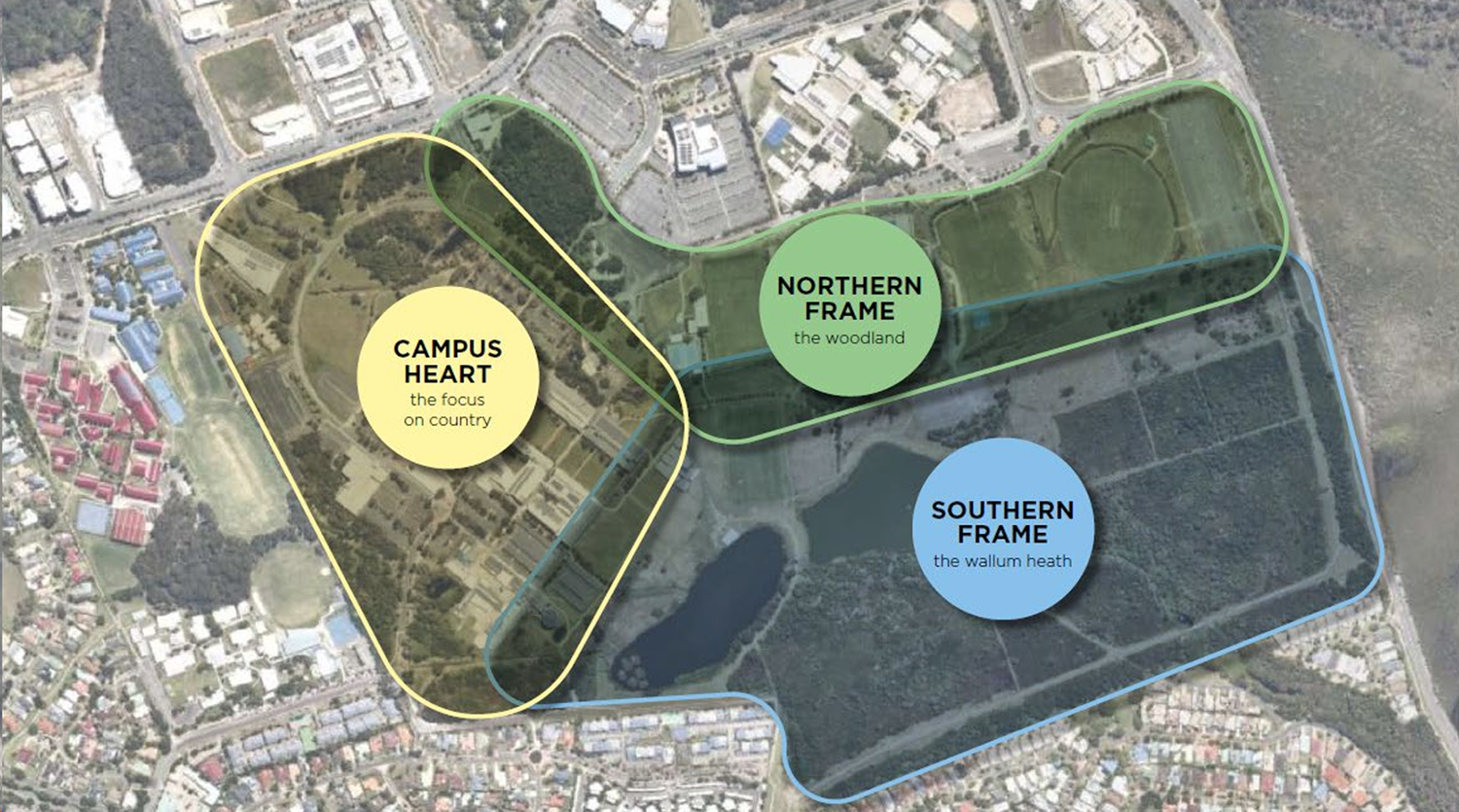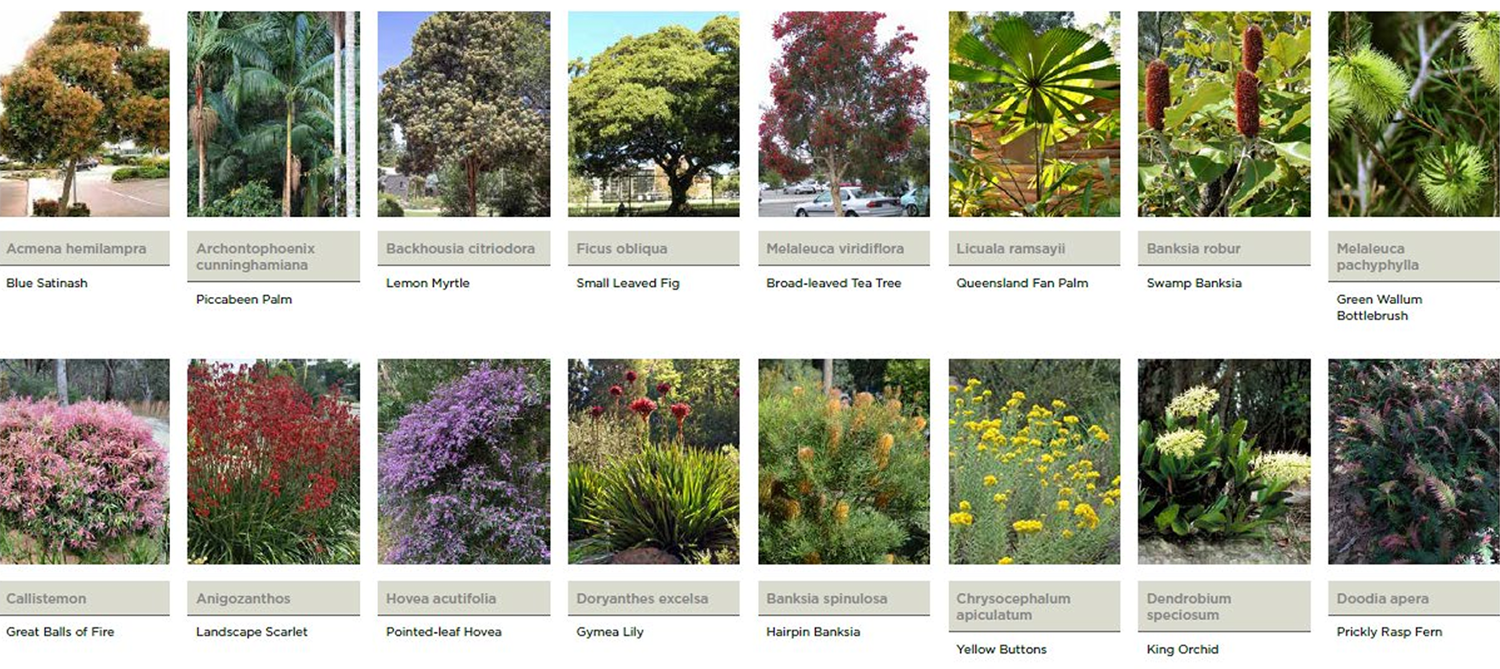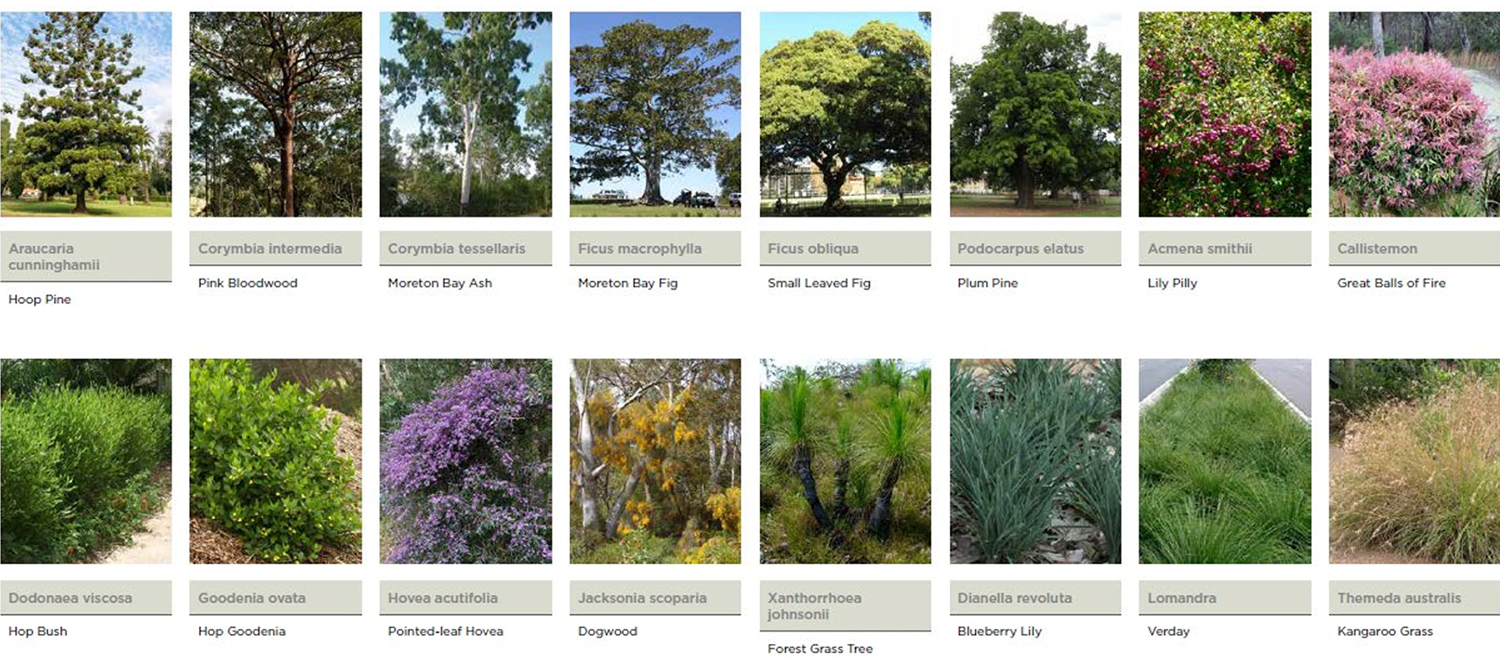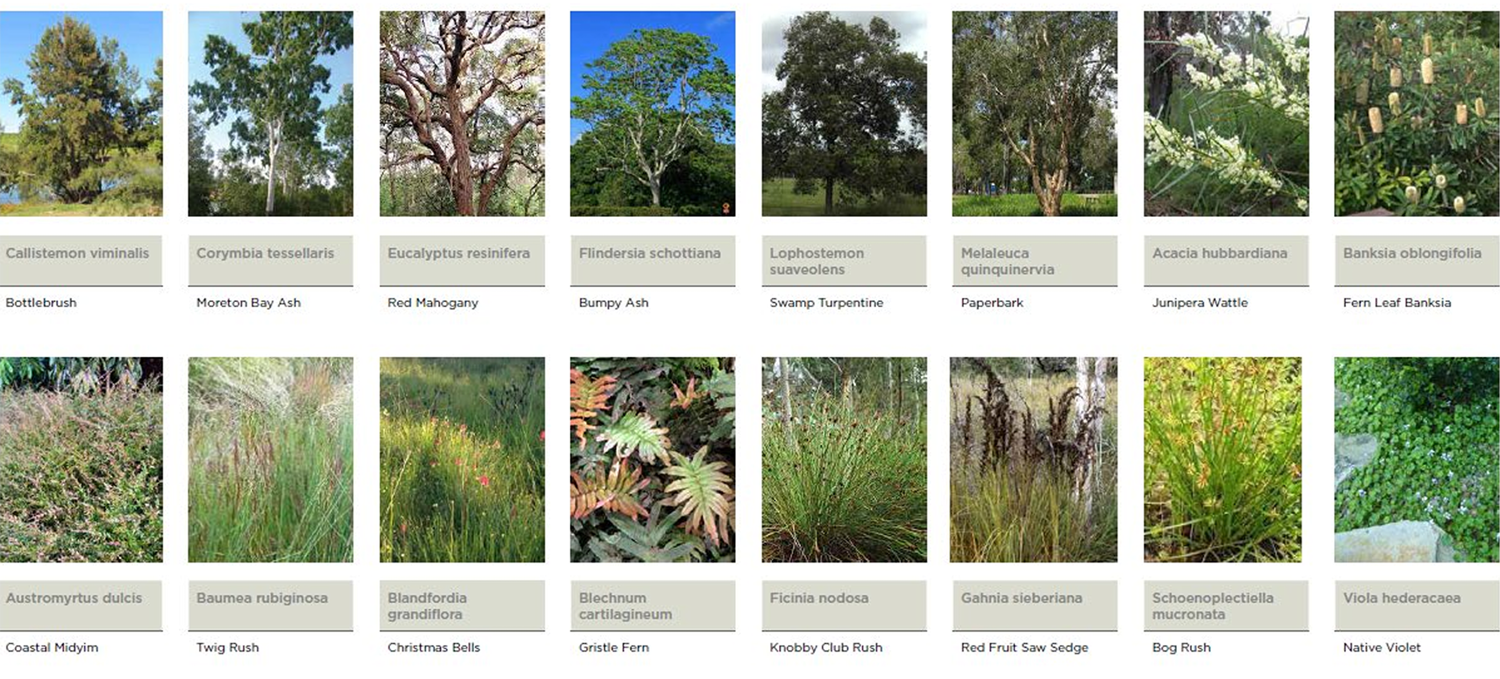Water-conscious planting. Plant landscapes to minimise water usage. (e.g. use drought-tolerant plants).
Planting list
An excerpt from UniSC Campus Masterplan 2023
The proposed selection of plants herein reinforces the landscape structure and hierarchy which has been established on the Sippy Downs campus since the University’s inception.
The plant list consists of Australian native and locally occurring species intended to contribute to the provision of appropriate habitat for fauna on the campus, including attracting further bird life.
Lessons from the successes and failures of previous plantings have been incorporated. Future decisions must be mindful of localised issues such as:
- Poor drainage, particularly near buildings and where lower lying clay soils exist,
- Wind tunnels around buildings, and
- Variable soil nutrient levels
Security issues and the provision of clear visibility day and night must also be taken into consideration. For example, planting adjacent car parks and along pathways is to be restricted to shade trees and low-lying vegetation.
The planting palette has been organised into three broad zones supporting existing and proposed campus activities.
Campus heart: Focus on Country
Campus Northern Frame: The Woodland
Campus Southern Frame: The Wallum Heath
Campus Heart
Focus on Country: Amplifying our relationship with Country at the very heart of the campus, this planting palette responds to the ancient landscape, the built environment and ongoing maintenance and operational considerations. The species have been selected against a criteria of being local to the area, having known First Nations’ uses, offering seasonality, have robustness in a built landscape and having a suitable respond to CPTED principles.
Intended to augment the existing Corymbia tessellaris planting, this selection of species is to be deployed informally in loose, staggered arrangements (refer indicative montage). Mounded landforms are anticipated here to improve drainage and to help frame campus activity.
Species have been coordinated with production lists of local nurseries.
Plant list
Campus heart: Focus on Country
| BOTANICAL NAME | COMMON NAME | FIRST NATIONS USE | AUSTRALIAN NATIVE | LOCALLY OCCURING | SUITABLE FOR WET AREAS | ||
|---|---|---|---|---|---|---|---|
| UPPER LEVEL | Sun | Acmena hemilampra | Blue Satinash | x | x | x | |
| Acronychia imperforata | Beach Acronychia | x | x | x | |||
| Archontophoenix cunninghamiana | Piccabeen Palm | x | x | x | |||
| Backhousia citriodora | Lemon Myrtle | x | x | ||||
| Banksia integrifolia | Coastal Banksia | x | x | x | x | ||
| Castanospermum australe | Black Bean | x | x | x | |||
| Elaeocarpus reticulatus | Blueberry Ash | x | x | x | |||
| Eucalyptus bancrofti | Pink Bloodwood | x | x | ||||
| Ficus obliqua | Small Leaved Fig2 | x | x | x | |||
| Glochidion ferdinandi | Cheese Tree | x | x | ||||
| Hymenosporum flavum | Native Frangipani | x | |||||
| Melaleuca quinquenervia | Broad Leaved Paperbark2 | x | x | x | x | ||
| Melaleuca viridiflora | Broad-leaved Tea Tree | x | x | ||||
| Podocarpus elatus | Plum Pine | x | x | x | |||
| Syzygium leuhmannii | Small Leaved Lilly Pilly | x | x | x | |||
| Syzygium oleosum | Blue Lilly Pilly | x | x | x | |||
| Tristaniopsis laurina | Water Gum | x | x | ||||
| Waterhousea floribunda | Weeping Lily Pilly | x | x | x | x | ||
| Shade | Atractocarpus fitzalanii | Brown Gardenia | x | x | |||
| Cyathea cooperi | Scaly Tree Fern | x | x | ||||
| Licuala ramsayii | QLD Fan Palm | x | |||||
| Livistona australis | Cabbage Tree Palm2 | x | x | x | |||
| Stenocarpus sinuatus | Firewheel Tree | x | x | ||||
| MID LEVEL | Sun | Backhousia myrtifolia | Grey Myrtle2 | x | x | x | |
| Banksia oblongifolia | Dwarf Banksia | x | x | x | |||
| Banksia robur | Swamp Banksia | x | x | x | x | ||
| Banksia spinulosa | Hairpin Banksia | x | x | x | |||
| Callistemon | Great Balls of Fire1 | x | |||||
| Casuarina | Greenwave1 | x | |||||
| Grevillea | Honey Gem1 | x | |||||
| Grevillea | Orange Marmalade1 | x | |||||
| Hovea acutifolia | Pointed-leaf Hovea | x | x | x | |||
| Leptospermum liversidgei | Olive Tea Tree | x | x | x | x | ||
| Melaleuca | Mini Quin1 | x | x | ||||
| Melaleuca pachyphylla | Green Wallum Bottlebrush | x | x | ||||
| Melaleuca thymifolia | Honey Myrtle | x | x | x | |||
| Phyllanthus cuscutiflorus | Pink Phyllanthus | x | |||||
| Xanthorrhoea johnsonii | Forest Grass Tree | x | x | x | |||
| Shade | Alpinia arrundelliana | Dwarf Native Ginger | x | x | x | ||
| Alpinia caerulea | Native Ginger2 | x | x | x | |||
| Atractocarpus chartaceus | Native Gardenia | x | x | x | |||
| Cordyline petiolaris | Broad Leaved Palm Lily | x | x | x | |||
| Doryanthes excelsa | Gymea Lily2 | x | x | ||||
| Melastoma malabathricum | Blue Tongue | x | x | x | |||
| LOWER LEVEL | Sun | Anigozanthos | Landscape Scarlet Kangaroo Paw1 | x | |||
| Austromyrtus dulcis | Coastal Midyim2 | x | x | x | |||
| Baeckea virgata | Dwarf Heath Myrtle | x | |||||
| Banksia | Roller Coaster1 | x | x | x | |||
| Callistemon | Little John1 | x | |||||
| Carpobrotus glaucescens | Coastal Pigface | x | x | x | |||
| Casuarina | Cousin It1 | x | |||||
| Chrysocephalum apiculatum | Yellow Buttons | x | x | ||||
| Dampiera stricta | Wallum Dampiera | x | x | ||||
| Dianella caerulea | Blue Flax Lily | x | x | x | |||
| Dianella longifolia | Tall Blue Flax Lily | x | x | x | |||
| Goodenia rotundiflolia | Cover Up1 | x | |||||
| Grevillea | Lime & Soda1 | x | |||||
| Grevillea | Bronze Rambler1 | x | |||||
| Lomandra | Verday1 | x | |||||
| Lomandra hystrix | Tropic Cascade1 | x | x | x | |||
| Myoporum parviolfium | Coastal Boobiala | x | |||||
| Pandorea jasminoides | Bower Vine | x | x | ||||
| Scaevola | Mauve Clusters1 | x | |||||
| Westringia | Mundi1 | x | |||||
| Xanthorrhoea fulva | Swamp Grass Tree | x | x | x | |||
| Shade | Adiantum hispidulum | Rough Maidenhair Fern | x | ||||
| Alocasia brisbanensis | Cunjevoi | x | |||||
| Asplenium australasicum | Bird Nest Fern | x | x | ||||
| Christella dentata | Binung | x | x | ||||
| Cissus antarctica | Kangaroo Vine2 | x | x | x | |||
| Davallia pyxidata | Hare's Foot Fern | x | x | ||||
| Dendrobum speciosum | King Orchid | x | x | ||||
| Doodia aspera | Prickly Rasp Fern | x | |||||
| Mentha diemenica | Native Mint | x | x | ||||
| Microsorum pustulatum | Kangaroo Fern | x | |||||
| Peperomia tetraphylla | Native Peperomia | x | x | ||||
| Viola hederacaea | Native Violet | x | x | x |
1. Cultivar - proven varieties suited to SEQ, to be used in the campus heart only
2. Common across all palettes
Northern Frame
The Woodland: The Northern Frame is the high ground which captures the sports precinct, Sippy Downs Drive frontage and surrounding landscape north of the two water bodies. Typically dryer and harsher growing conditions, the planting palette contains hardier species which offer amenity, habitat and connections back to ancient landscapes while being appropriate for this modern and functional precinct (refer indicative montage).
Plant list
Campus Northern Frame: The Woodland
| BOTANICAL NAME | COMMON NAME | FIRST NATIONS USE | AUSTRALIAN NATIVE | LOCALLY OCCURING | SUITABLE FOR WET AREAS | ||
|---|---|---|---|---|---|---|---|
| UPPER LEVEL | Sun | Araucaria cunninghamii | Hoop Pine | x | x | ||
| Backhousia citriodora | Lemon Myrtle | x | x | ||||
| Castanospermum australe | Black Bean | x | x | x | |||
| Corymbia intermedia | Pink Bloodwood | x | x | x | |||
| Corymbia racemosa | Scribbly Gum | x | x | ||||
| Corymbia tessellaris | Moreton Bay Ash | x | x | x | |||
| Cupaniopsis parvifolia | Small Leaved Tuckeroo | x | |||||
| Ficus macrophylla | Moreton Bay Fig | x | x | x | |||
| Ficus obliqua | Small Leaved Fig2 | x | x | x | |||
| Ficus rubiginosa | Port Jackson Fig | x | x | x | |||
| Flindersia australis | Crow's Ash | x | |||||
| Livistona australis | Cabbage Tree Palm2 | x | x | x | |||
| Lophostemon confertus | Brush Box | x | x | x | |||
| Melaleuca quinquenervia | Broad Leaved Paperbark2 | x | x | x | x | ||
| Podocarpus elatus | Plum Pine | x | x | x | |||
| Syncarpia glomulifera | Turpentine | x | x | ||||
| MID LEVEL | Sun | Acacia falcata | Sickle Wattle | x | x | x | |
| Acacia hubbardiana | Yellow Prickly Moses | x | x | x | |||
| Acacia myrtifolia | Myrtle Wattle | x | x | x | |||
| Acmena smithii | Lily Pilly | x | x | x | |||
| Backhousia myrtifolia | Grey Myrtle | x | x | x | |||
| Callistemon | Great Balls of Fire1 | x | |||||
| Dodonaea viscosa | Hop Bush | x | x | x | |||
| Goodenia ovata | Hop Goodenia | x | x | ||||
| Grevillea | Honey Gem1 | x | |||||
| Hovea acutifolia | Pointed-leaf Hovea | x | x | x | |||
| Jacksonia scoparia | Dogwood | x | x | x | |||
| Leptospermum polygalifolium | Tantoon | x | x | x | x | ||
| Melaleuca linariifolia | Narrow Leaved Paperbark | x | x | x | x | ||
| Oxylobium robustum | Golden Shaggy Pea | x | x | ||||
| Xanthorrhoea johnsonii | Forest Grass Tree | x | x | x | |||
| Shade | Alpinia caerulea | Native Ginger2 | x | x | |||
| Cordyline petiolaris | Broad Leaved Palm Lily | x | x | x | |||
| Doryanthes excelsa | Gymea Lily2 | x | x | ||||
| LOWER LEVEL | Sun | Austromyrtus dulcis | Coastal Midyim2 | x | x | x | |
| Baeckea virgata | Dwarf Heath Myrtle | x | |||||
| Callistemon | Little John1 | x | |||||
| Chrysocephalum apiculatum | Yellow Buttons | x | x | ||||
| Cymbopogon refractus | Barbwire Grass | x | x | x | |||
| Dianella revoluta | Blueberry Lily | x | x | ||||
| Goodenia rotundiflolia | Cover Up1 | x | |||||
| Lomandra | Verday1 | x | |||||
| Lomandra hystrix | Mat Rush | x | x | x | |||
| Myoporum parviolfium | Coastal Boobiala | x | |||||
| Pandorea jasminoides | Bower Vine | x | x | ||||
| Themeda australis | Kangaroo Grass | x | x | x | |||
| Westringia | Mundi1 | x | |||||
| Shade | Cissus antarctica | Kangaroo Vine2 | x | x | |||
| Dianella longifolia | Tall Blue Flax Lily | x | x | x | |||
| Hibbertia scandens | Snake Vine | x | x |
1. Cultivar - proven varieties suited to SEQ, to be used in the campus heart only
2. Common across all palettes
Southern Frame
The Wallum Heath: Drawing on the diversity of the Mooloolah River National Park and the originally translocated vegetation from Brightwater, the planting palette looks to complement and expand on the local ecosystems. The palette creates the initial framework for future revegetation and landscape projects within areas around and to the south-east of the water bodies (refer indicative montage).
Plant list
Campus Southern Frame: The Wallum Heath
| BOTANICAL NAME | COMMON NAME | FIRST NATIONS USE | AUSTRALIAN NATIVE | LOCALLY OCCURING | SUITABLE FOR WET AREAS | ||
|---|---|---|---|---|---|---|---|
| UPPER LEVEL | Sun | Araucaria cunninghamii | Hoop Pine | x | x | ||
| Backhousia citriodora | Lemon Myrtle | x | x | ||||
| Castanospermum australe | Black Bean | x | x | x | |||
| Corymbia intermedia | Pink Bloodwood | x | x | x | |||
| Corymbia racemosa | Scribbly Gum | x | x | ||||
| Corymbia tessellaris | Moreton Bay Ash | x | x | x | |||
| Cupaniopsis parvifolia | Small Leaved Tuckeroo | x | |||||
| Ficus macrophylla | Moreton Bay Fig | x | x | x | |||
| Ficus obliqua | Small Leaved Fig2 | x | x | x | |||
| Ficus rubiginosa | Port Jackson Fig | x | x | x | |||
| Flindersia australis | Crow's Ash | x | |||||
| Livistona australis | Cabbage Tree Palm2 | x | x | x | |||
| Lophostemon confertus | Brush Box | x | x | x | |||
| Melaleuca quinquenervia | Broad Leaved Paperbark2 | x | x | x | x | ||
| Podocarpus elatus | Plum Pine | x | x | x | |||
| Syncarpia glomulifera | Turpentine | x | x | ||||
| MID LEVEL | Sun | Acacia falcata | Sickle Wattle | x | x | x | |
| Acacia hubbardiana | Yellow Prickly Moses | x | x | x | |||
| Acacia myrtifolia | Myrtle Wattle | x | x | x | |||
| Acmena smithii | Lily Pilly | x | x | x | |||
| Backhousia myrtifolia | Grey Myrtle2 | x | x | x | |||
| Callistemon | Great Balls of Fire1 | x | |||||
| Dodonaea viscosa | Hop Bush | x | x | x | |||
| Goodenia ovata | Hop Goodenia | x | x | ||||
| Grevillea | Honey Gem1 | x | |||||
| Hovea acutifolia | Pointed-leaf Hovea | x | x | x | |||
| Jacksonia scoparia | Dogwood | x | x | x | |||
| Leptospermum polygalifolium | Tantoon | x | x | x | x | ||
| Melaleuca linariifolia | Narrow Leaved Paperbark | x | x | x | x | ||
| Oxylobium robustum | Golden Shaggy Pea | x | x | ||||
| Xanthorrhoea johnsonii | Forest Grass Tree | x | x | x | |||
| Shade | Alpinia caerulea | Native Ginger2 | x | x | |||
| Cordyline petiolaris | Broad Leaved Palm Lily | x | x | x | |||
| Doryanthes excelsa | Gymea Lily2 | x | x | ||||
| LOWER LEVEL | Sun | Austromyrtus dulcis | Coastal Midyim2 | x | x | x | |
| Baeckea virgata | Dwarf Heath Myrtle | x | |||||
| Callistemon | Little John1 | x | |||||
| Chrysocephalum apiculatum | Yellow Buttons | x | x | ||||
| Cymbopogon refractus | Barbwire Grass | x | x | x | |||
| Dianella revoluta | Blueberry Lily | x | x | ||||
| Goodenia rotundiflolia | Cover Up1 | x | |||||
| Lomandra | Verday1 | x | |||||
| Lomandra hystrix | Mat Rush | x | x | x | |||
| Myoporum parviolfium | Coastal Boobiala | x | |||||
| Pandorea jasminoides | Bower Vine | x | x | ||||
| Themeda australis | Kangaroo Grass | x | x | x | |||
| Westringia | Mundi1 | x | |||||
| Shade | Cissus antarctica | Kangaroo Vine2 | x | x | |||
| Dianella longifolia | Tall Blue Flax Lily | x | x | x | |||
| Hibbertia scandens | Snake Vine | x | x |
1. Cultivar - proven varieties suited to SEQ, to be used in the campus heart only
2. Common across all palettes
Planting procurement and maintenance
The ultimate size and horticultural performance of each plant requires careful consideration of species selection. Additionally, careful selection of nursery stock as well as the size at planting is essential to achieving quality outcomes. Where possible it is desirable for plants to be grown to consignment. This ensures that plants are at an optimum size for their containers when planted out.
The size of trees at the time of planting also needs to be carefully considered. While it is desirable for advanced specimens to be selected, this needs to be balanced with the particular soil conditions, drainage requirements and the ability for an advanced tree to become established.
In more informal areas plants of different sizes can be planted at the same time. Advanced specimens provide immediate visual impact while smaller plants can become established over time. This method of planting allows for failures over time, especially of the more advanced stock, without causing major visual impact.
As many species as possible should be obtained locally, prioritising local seed provenance.
Plantings should be mulched preferably with aged and composted mulch. Some locations such as the waterways could use pebble and stone mulch.
A management plan should be prepared to guide site revegetation.
A gradual increase in planting as the campus expands is anticipated. This needs to be matched with ongoing reviews of appropriate levels of maintenance resources. Part of this process includes planned, ongoing monitoring of plant growth, changes to site conditions, and success or failure of plantings to feedback into future decisions.
It is most important that grounds-staff have the appropriate skills to carry out the varied requirements of successfully planting and maintaining the campus landscape. Skills in planting procedures, irrigation, fertilising, weed control, turf management and tree management, for example, are likely to be needed. At all times Environmental Protection Agency Guidelines should be followed.





